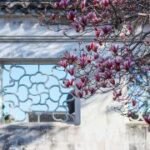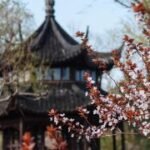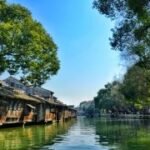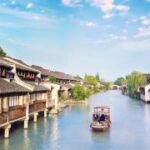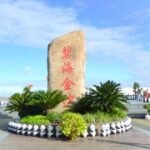Ou Garden, originally named She Garden, was renovated by Shen Bingcheng during the Tongzhi era of the Qing Dynasty into its current layout. It was named ‘Ou Garden’, which signifies a residential area in the middle, flanked by two gardens on either side, resembling the shape of a lotus root, and also symbolizes the couple who retreated to the garden for eight years during Shen’s low point in life, where he met the talented Yan Yonghua, hence the term ‘a fine couple’. The garden is ideal for couples and also for tourists who wish to quietly savor the charm of Suzhou gardens, as it lacks the hustle and bustle of the Humble Administrator’s Garden or the Lion Grove Garden.
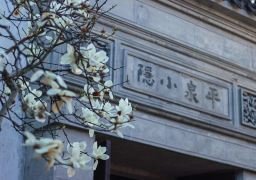
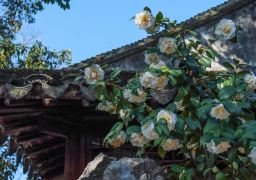
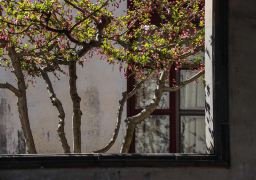

The central residential area is accessed through a modest door, leading to the southernmost entrance hall, followed by the sedan chair hall, the main hall known as Zaijiu Hall, and the building hall. The brick-carved archway in front of the building hall, inscribed with ‘Poetry and Wine United in Joy’, is exquisite. Inside, one can listen to Suzhou Pingtan performances, with the audience able to request songs from the performers, each with different prices depending on the piece.
The Eastern Garden’s highlights are the essence of Ou Garden, with two main attractions. The first is the robust yellow stone rockeries, with the main eastern mountain, Liu Yunxu, plunging into the moon-reflecting pool on the east side, and the western hill, Tao Yu, creating a canyon-like ‘Sui Gu’ between them. Walking through this, visitors experience steep cliffs on either side, with stone steps leading up the mountain, integrating the landscapes of famous mountains and rivers into this small garden, making the rockeries appear as real mountains. The second attraction is the杞梓wood ‘Three Friends in Cold Age’ floor screen in the south of the landscape, resembling a door frame, with its intricate openwork wood carving, said to be a remnant from the Ming Dynasty. The main hall of the Eastern Garden, Chengqu Caotang, is located in the north, embraced by two long corridors. The Xi Corridor extends southward, passing by Yan Yonghua’s study, Wusu Yunxuan, where her written couplet ‘Ou Garden Houses a Fine Couple, Chengqu Builds a Poem City’ is displayed, with the horizontal scroll ‘Pillow Wave Dual Hideaway’, a very famous couplet expressing the couple’s deep love. The Jun Corridor on the east side has a half-kiosk, with the ‘Lun Yuan Tu’ stele on the pavilion wall, created by the early Qing master Wang Wenzhi, and also bearing the autographs of the Shen couple, making it extremely precious. The Wu’ai Pavilion in the east of the garden is where Yan Yonghua played the zither, next to which is the Tingqin Xuan where Shen Bingcheng listened to her play. The garden is filled with details reflecting the couple’s simple and enduring love, worth exploring one by one.
The Western Garden’s main hall, Zhilian Laowu, serves as a study, with the collection building to the north, and the Heshou Pavilion built against the wall to the east, with the brick-carved flower windows on the corridor walls also being quite beautiful. To the south, there is a rockeries, corresponding to the yellow stone rockeries of the Eastern Garden. The Western Garden is small but exquisite, indeed a good place for the owner to read.
Ou Garden is surrounded by rivers on three sides and opens to a street on one side. At the northwest of Chengqu Caotang, the cruise ship dock protrudes from the garden’s wall, and having a private dock is another distinctive feature of Ou Garden. Visitors can take a hand-oar boat that travels along the high walls of the garden to the city’s moat green belt, where a section of the new city wall can also be seen.
Visiting Surrounding Attractions of Couple’s Garden: The Couple’s Garden can be easily toured and is often combined with nearby attractions. Don’t miss the unremarkable Double Well Hundred Springs at the intersection of Cangjie Street and Da Xinqiao Lane outside the garden. To the south, you can visit the Xiangmen City Gate and Soochow University. To the north, you can explore the adjacent East Garden, which is essentially an urban park. To the west, you can visit the hidden miniature garden Bei Ban Yuan, stroll through the historical Pingjiang Road district, and enjoy local cuisine on Guanqian Street. To the northwest, you can find the Lion Grove Garden and the Humble Administrator’s Garden, which are approximately 1.5 to 2 kilometers away. Opening hours are from March 1st to October 31st, 07:30 to 17:30; from November 1st to February 28th, 07:30 to 17:00. Concessions: Children aged 6 and under or with a height of 1.4 meters and under, accompanied by an adult, enter free of charge. Minors aged between 6 and 18, inclusive, enjoy half-price admission. Elderly: Seniors aged 70 and above, inclusive, with a Senior Citizen Card or ID card, enter free of charge. Seniors aged between 60 and 69, inclusive, with a valid ID card or Senior Citizen Certificate, enjoy half-price admission. Students: Full-time undergraduate students and below, with a valid ID card or student certificate, enjoy half-price admission. Military personnel: Active military personnel and disabled veterans with a military ID and disabled veteran certificate, as well as retired military officers and retired military personnel with a retired military officer certificate, enter free of charge. Disabled: People with disabilities across the country with a valid Disability Certificate enter free of charge. Severely disabled individuals can have one free accompanying carer enter the garden. Blood donation volunteers: Individuals who have won national awards for voluntary blood donation, voluntary donation of hematopoietic stem cells, and lifelong honorary awards for voluntary blood donation services, with relevant documents, enter free of charge. Fire and rescue personnel: Active, retired, and disabled fire and rescue personnel, as well as students from fire and rescue academies, with valid documents, enter free of charge. Concessions for preferential treatment: With a ‘People’s Republic of China Veterans Preferential Treatment Certificate’ or ‘People’s Republic of China Martyrs, Military Personnel Who Died in the Line of Duty, Sick Military Personnel Dependents Preferential Treatment Certificate’ (excluding garden within the garden, garden charges, and night tour projects), enter free of charge. Suzhou medical staff: On International Nurses’ Day (May 12th) and China Physicians’ Day (August 19th) each year, medical staff in Suzhou can enjoy free visits to scenic spots within 7 days from the day of the festival (May 12th to 18th, August 19th to 25th). When visiting the scenic spots, Suzhou medical staff should present their ‘Personal ID Card’ + ‘Suzhou Medical Staff Free Garden Card (electronic card)’, and can enter the park without an appointment, with the first ticket fee waived.
Free service facilities – Parking lot: [Dongyuan Parking Lot]. Reference price: Free. Address: No. 6, Xiaoxin Bridge Lane, Cang Street, Gusu District, Suzhou City. Number of parking spaces: 50.

